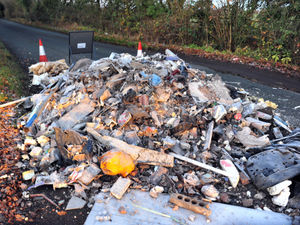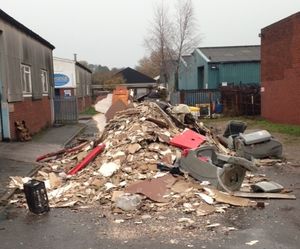Gangs dump lorry loads of rubbish as figures reveal fly-tipping frenzy
Organised criminal gangs are dumping lorry-loads of rubbish across the Black Country and Staffordshire as part of an illegal waste clearing service, it has been revealed.

Analysis found the number of such incidents had more than doubled since 2012, with rises seen across the region.
Each year, councils across England and Wales collate the number, size and cost of illegal rubbish dumping in their areas.
Anything above the size of a lorry-load can be investigated by the Environment Agency, though the cost of clearance lies with the local council.
South Staffordshire saw the biggest rise, with 60 incidents of large-scale fly-tipping in 2019 when compared with 2012.
Walsall has the region's largest yearly average, at 108.125, and also saw a rise of 24 over the seven-year analysis.

The total number of reported incidents hit 865, more than double than that seen in Wolverhampton, which had a yearly average of 47 large-scale fly-tip incidents, with a peak of 123 in 2018-19.
Wyre Forest was another of the region's worst affected areas, with a rise of 31 reported incidents – and again 2018-19 was the worst year with 49 cases.
Councillor John Thomas, Wyre Forest District Council’s Cabinet Member for Operational Services, said: "Since February 2018, there were 141 incidents of fly-tipping reported across Wyre Forest, blighting the district, costing thousands of pounds of public funds to clear away.
"The council is currently running a Let’s SCRAP Flytipping campaign, which aims to reduce the amount of waste being dumped by the roadside and at local beauty spots.
"We are encouraging residents, businesses and landlords to help tackle this problem and prevent waste from getting into the hands of fly-tippers and report incidents so action can be taken against those responsible."

Dudley saw a steep rise, from just six incidents in 2011-12, climbing to 29 by 2018-19.
Sandwell averaged 23.623 incidents each year, rising from 16 in 2011-12 to 23 in 2018-19, peaking with 58 in 2013-14.
Leader of Sandwell Council Councillor Yvonne Davies said: “Fly-tipping is on the rise nationally – our residents don’t accept this kind of behaviour and neither do we.
“As a council we are very effective at dealing with fly-tipping and in the past two years we have issued 165, £400, fines to people who we have been able to prove are responsible for fly-tipping rubbish in Sandwell.

"We’ve achieved this by using the valuable information we receive from residents and targeting key frontline services on providing an efficient response.
“We have also placed CCTV cameras in hotspots and residents have also provided video footage to us to help us take action. "We encourage people to report all incidents they see, with evidence, to help us use the enforcement powers we have.
“Sandwell provides weekly domestic waste and recycling collections, plus free garden and food waste collections. Very few councils still provide this level of service."
Councillor Davies said new £400 fines for residents who used unlicensed waste carriers to dispose of household waste would also be introduced on March 1.
Staffordshire picture
Other areas of Staffordshire were affected less with a rise of just one large-scale fly-tipping incident in Cannock Chase, although figures had risen from two up to seven in both 2013-14 and 2014-15, before dropping to three.
Lichfield saw an overall rise of of five incidents. After nine reports in 2011-12, it peaked at 31 in 2016-17, before dropping back down to 14 in 2018-19.
Councillor Angela Lax, Lichfield District Council’s Cabinet Member for Legal and Regulatory Services, said: “An increase in large-scale fly-tipping is a cause for concern and something which we are working in partnership to tackle, including with the police, Environment Agency and fire service.
“Although responsible for removing fly-tipping from public places, anything that is more than a transit van load primarily is investigated by the Environment Agency.
"However, across our district most large scale fly-tipping is generally on private land, which falls under the landowner’s responsibility to clean up and the Environment Agency to investigate, working with partner agencies.
“Using private land, including warehouses, is an area that criminal gangs exploit. We have written to landowners and businesses to give them advice about how to secure their property and land, so they are not vulnerable to this type of crime.
“We investigate all smaller scale fly-tipping cases on public land to find evidence of who the culprits are, including checking through the waste and asking for witnesses to come forward. In some cases, officers have also gone undercover to prove a suspected offender is dumping waste illegally.
“We collate our figures for fly-tipping removal on public land, such as roads and district council owned land, which means our larger-scale fly-tipping clean-up costs are mixed in with smaller tips.
"From 2018 to 2019, it cost us £18,604 to remove all sizes of fly-tipping from public places. The investigation and enforcement costs, within this timeframe came to approximately £8,000.”
Stafford was the only area to see a fall, with just three incidents reported over the entire seven years, and none at all for the last four years.
Councillor Jonathan Price, Cabinet Member for Environment at Stafford Borough Council, said: “The public are rightly angered when others treat our borough as a dumping site.
"It is a blight on our community and we take a zero tolerance approach to environmental crime. Our message has always been very simple – if you litter our borough, be prepared to be fined or prosecuted.”
While the total number of fly-tipping incidents in England has hovered around the one million mark in recent years, the largest type of tips – sometimes covering whole parks – has risen 117 per cent since 2012.
Analysis found councils spent more than £59m on removing dumped rubbish since 2012.
Wales, on the other hand, has seen large fly-tipping decrease since 2012, a trend officials believe is down to the success of a national campaign.
Data for Scotland and Northern Ireland is not held publicly.





